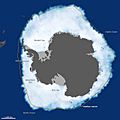Landmass facts for kids
A landmass is a very large area of land. Think of it as a huge piece of Earth's surface. These big land areas are usually separated from each other. They might be separated by a huge ocean, a narrow strip of land called an isthmus, or even a human-made canal. For example, North America and South America are two huge landmasses. They are connected by the Isthmus of Panama, but also separated by the Panama Canal.
Contents
What is a Landmass?
A landmass is simply a very big piece of land. It's much larger than an island. The biggest landmasses on Earth are called continents. There are seven main continents. These are Africa, Antarctica, Asia, Australia, Europe, North America, and South America. Sometimes, Europe and Asia are grouped together. This combined landmass is called Eurasia.
How Earth's Big Land Areas Were Made
Earth's landmasses haven't always looked the way they do today. Billions of years ago, our planet was very different. The land we see now formed over a very long time. This happened through a process called plate tectonics.
Moving Plates and Continents
The Earth's outer layer, called the lithosphere, is broken into huge pieces. These pieces are like giant puzzle parts. We call these parts tectonic plates. These plates are always moving, but very slowly. They float on a softer, hotter layer beneath them. This movement is usually just a few centimeters each year.
Over millions of years, these slow movements add up. They can cause continents to drift apart. They can also make continents crash into each other. This process is called continental drift. It explains why the continents look like they could fit together. Scientists believe all landmasses were once joined. They formed a supercontinent called Pangaea.
How Landmasses Are Separated
Landmasses are separated by different natural features. The most common separation is by large bodies of water.
Oceans and Seas
The biggest separations are the oceans. The Pacific Ocean, Atlantic Ocean, and Indian Ocean divide the continents. For example, the Atlantic Ocean separates North and South America from Europe and Africa. Smaller bodies of water, like seas, can also separate landmasses. The Mediterranean Sea separates parts of Europe from Africa.
Isthmuses and Canals
Sometimes, landmasses are almost connected. They might have a very narrow strip of land between them. This narrow strip is called an isthmus. The Isthmus of Panama connects North and South America.
Humans have also created ways to separate landmasses. They dig canals through these narrow strips of land. The Panama Canal was built across the Isthmus of Panama. It allows ships to travel between the Atlantic and Pacific Oceans. This canal effectively separates North and South America for shipping purposes. Another example is the Suez Canal. It connects the Mediterranean Sea to the Red Sea. This canal separates Africa from Asia.
Why Landmasses Are Important
Landmasses are incredibly important for life on Earth. They provide the space for almost all living things.
Home to Life
Every landmass has its own unique plants and animals. These are called flora and fauna. Different climates and environments exist on each landmass. From hot deserts to cold tundras, landmasses offer diverse habitats. This diversity supports a huge variety of life.
Resources and Human Life
Landmasses provide many natural resources. These include fresh water, minerals, and fertile soil for farming. Humans build cities and towns on landmasses. They use the resources to live and grow. Understanding landmasses helps us learn about Earth's history. It also helps us understand how our planet works.
Images for kids
-
An image of Antarctica differentiating its landmass (dark grey) from its ice shelves (minimum extent, light grey, and maximum extent, white)


